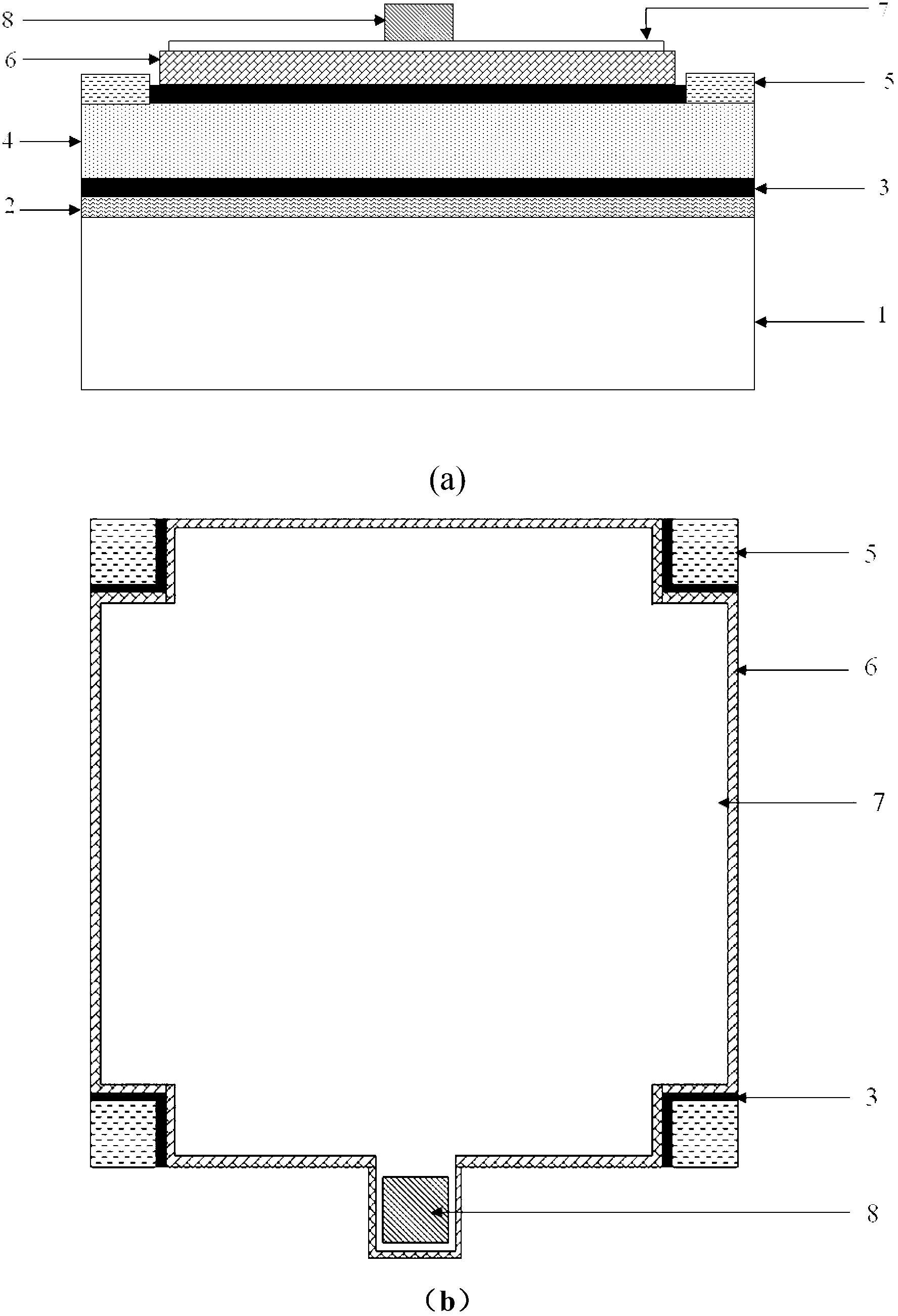Tellurium-cadmium-mercury grid-controlled structure photoconductive detector for Hall test
A mercury cadmium telluride and structured light technology, which is applied in the direction of semiconductor devices, sustainable manufacturing/processing, electrical components, etc., to achieve the effect of shortening the development process and simplifying the preparation process
- Summary
- Abstract
- Description
- Claims
- Application Information
AI Technical Summary
Problems solved by technology
Method used
Image
Examples
example 1
[0018] Step 1: De-damaging the flatness of the first surface of the n-type HgCdTe material 4, wherein Hg 1-x Cd x In Te, x=0.21, at liquid nitrogen temperature, the mobility is about 3×10 4 cm 2 / (V s), the electron concentration is about 1×10 13 cm -3 . An anodized layer 3 with a thickness of 80 nm is grown on its surface.
[0019] Step 2: Paste the processed side of the mercury cadmium telluride material 4 with the sapphire substrate 1 with the prepared epoxy resin glue 2, and fully cure under pressure at a certain temperature (about 60°C) under vacuum to ensure The adhesive layer is within a certain uniform thickness range, and the curing time is about 90mins to ensure the adhesive strength.
[0020] Step 3: Paste the processed chip on the first side on the ground glass plate with wax, and then flatten it with a vacuum silicon wafer machine (to ensure that the thickness difference is within 3 μm), and make the other side of the mercury cadmium telluride material In t...
example 2
[0030] Step 1: De-damaging the flatness of the first surface of the n-type HgCdTe material 4, wherein Hg 1-x Cd x In Te, x=0.26, at liquid nitrogen temperature, the mobility is about 1×10 5 cm 2 / (V·s), the electron concentration is about 2×10 14 cm -3 . An anodized layer 3 with a thickness of 90 nm is grown on its surface.
[0031] Step 2: Paste the processed side of the mercury cadmium telluride material 4 with the sapphire substrate 1 with the prepared epoxy resin glue 2, and fully cure under pressure at a certain temperature (about 60°C) under vacuum to ensure The adhesive layer is within a certain uniform thickness range, and the curing time is about 90mins to ensure the adhesive strength.
[0032] Step 3: Paste the processed chip on the first side on the ground glass plate with wax, and then flatten it with a vacuum silicon wafer machine (to ensure that the thickness difference is within 3 μm), and make the other side of the mercury cadmium telluride material Thin...
example 3
[0042] Step 1: De-damaging the flatness of the first surface of the n-type HgCdTe material 4, wherein Hg 1-x Cd x In Te, x=0.23, at liquid nitrogen temperature, the mobility is about 5×10 4 cm 2 / (V s), the electron concentration is about 1×10 15 cm -3 . An anodized layer 3 with a thickness of 100 nm is grown on its surface.
[0043] Step 2: Paste the processed side of the mercury cadmium telluride material 4 with the sapphire substrate 1 with the prepared epoxy resin glue 2, and fully cure under pressure at a certain temperature (about 60°C) under vacuum to ensure The adhesive layer is within a certain uniform thickness range, and the curing time is about 90mins to ensure the adhesive strength.
[0044] Step 3: Paste the processed chip on the first side on the ground glass plate with wax, and then flatten it with a vacuum silicon wafer machine (to ensure that the thickness difference is within 3 μm), and make the other side of the mercury cadmium telluride material Thi...
PUM
| Property | Measurement | Unit |
|---|---|---|
| Thickness | aaaaa | aaaaa |
| Thickness | aaaaa | aaaaa |
| Electron concentration | aaaaa | aaaaa |
Abstract
Description
Claims
Application Information
 Login to View More
Login to View More - R&D
- Intellectual Property
- Life Sciences
- Materials
- Tech Scout
- Unparalleled Data Quality
- Higher Quality Content
- 60% Fewer Hallucinations
Browse by: Latest US Patents, China's latest patents, Technical Efficacy Thesaurus, Application Domain, Technology Topic, Popular Technical Reports.
© 2025 PatSnap. All rights reserved.Legal|Privacy policy|Modern Slavery Act Transparency Statement|Sitemap|About US| Contact US: help@patsnap.com

